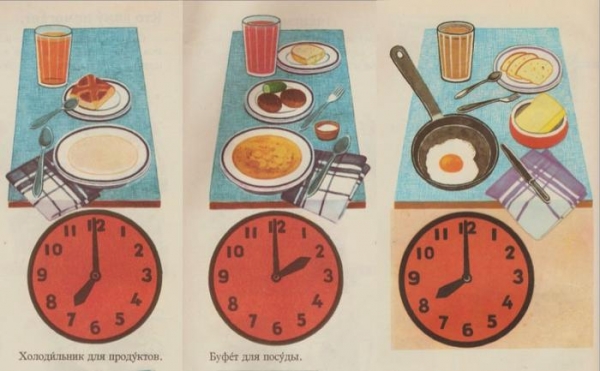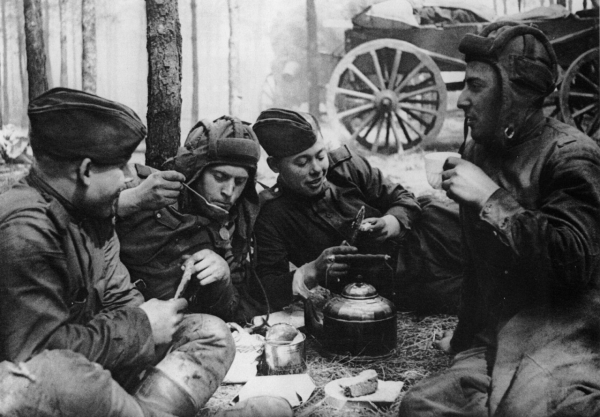
One of the myths spread by fans of the USSR — it’s about how well and efficiently fed people in this country. Say, the Soviet Union was the quality and variety of products manufactured exclusively from natural raw materials, and the state strongly followed the health of its citizens.
In fact, the people in the USSR ate poorly and bad. In the main picture in the post shows a picture from the book “Russian language in pictures”, published in the 70-80-ies and offering the examples of “ordinary Soviet life” to teach Russian language. The topic of food is quite accurately depicted the standard diet of the Soviet people — Breakfast, lunch and dinner. Breakfast is some kind of cereal (probably oatmeal or semolina) cake and tea. Lunch — a greasy soup, two fried patties and a slice of cucumber, dinner — scrambled eggs with cheese and butter. Now, even in the various “public houses” presents a much better and more varied diet.
Meanwhile, something like this like the picture, the Soviet people eat every day. Standard Soviet table consisted of the following list of products:
— Soups. All kinds of “soup”, “soup”, “potato soup”, “soups macaroni and other stuff, not carrying for the body almost no nutrients because the digested bones and overcooked vegetables nothing useful there, all the vitamins and biologically active substances already killed at a temperature of about 60 hrusov. In the Soviet Union was a very widespread myth, though the consumption of soups saves you from gastritis, so a daily chlebana liquid Burda (often preparing a huge pot for 3-4 days, and every day heat) did not cause any negative emotions.
— Kashi. Semolina, oats, buckwheat, millet, rice. The endless stream of junk in such quantity to the body of carbs and glucose that leads to diabetes. Consumed as a separate dish for Breakfast/dinner and as a side dish to some burgers for lunch. Was quite common in the Soviet Union, as they are cheap and majority” soldering, used in particular in the army and prisons.
— Pasta. Another source is not very useful for the body of carbohydrates. Used both separately and as a garnish. By the way, what was served at that time in the cafeterias under the guise of pasta, was not like the current kachestvennye pasta from durum wheat.
— Potato — starch carbohydrates. Roasted, cooked in their jackets, served in the form of puree, etc. a Rich, but essentially useless to the body food, especially in the quantities in which it was consumed.
— Sandwiches. Very popular in Soviet Union topic, all on the same principle of saaristotie and controlled flow of valuable products in short supply — for example, smoked sausage or sprats.
— Candy, jam. Another source of “fast” carbohydrates. Discourage the appetite, are of no benefit, spoil the teeth.
— Eggs, omelets. Cheap and relatively affordable source of protein, but also quite harmful product for everyday use, since it contains a lot of harmful cholesterol
— Sausages, sausages, offal. This item can be amnesic all few diet sovetskih meat departments. Meat in the modern sense was not sold, and what I had managed to snatch a few lucky ones, in the best case, after careful handling and diluting onions/baguette could go on burgers.
— Tea and cheap biscuits. Carbohydrates, carbohydrates, carbohydrates and dental caries. Even now older people love the “snacks”, although it is better instead of useless tea and biscuits to eat some fruit or carrots.
Need to add that in the USSR all the food ELOS bread — this habit is still strong in people who caught the Soviet Union in adulthood. Bread ELOS even potatoes and pasta, by themselves, are a source of carbohydrates.
In principle, this is all. That this diet was 80-90% power of the ordinary citizen in the Soviet Union, which did not have access spetsmagazinah and other nishtyak, available to a select few. This potato-soup diet occasionally diluted meat blue hens, self-caught freshwater fish, canned fish and bacon/sour cream from relatives from the village. No need to be a nutritionist to see perenoshennoy this diet in the direction of an incredible amount of carbohydrates in diferite high-quality protein, vitamins and minerals.
This sad truth about the food the Soviet people — one of the reasons why fans of the USSR do not like to discuss the beggar Soviet way of life, and prefer to talk about “higher spiritual matters” and that “you have all of the material, let’s talk about the spiritual, about the most widely read of the nation”, that’s all. This is for one simple reason — the topic of nutrition, there is no esotericism, no place for any verbally cheating, there is a clear and verifiable criteria for normal human existence and the full development you need a certain amount of calories, recruit a certain amount of proteins, fats, carbohydrates and vitamins. In the USSR most people said they were unavailable, period.
Remember the grandmothers who took your peers to kindergarten — bad teeth and hair, sagging gray skin, early wrinkles, gray hair, problems with musculoskeletal disorders, problems with body weight — but many of them were barely over fifty. It is the result of years of poor nutrition, which does not hide any stories about the highest in the world milk yield and first place for completing the barn.
Anyone who wants to get back in the kitchen and eat “in the USSR”, can easily arrange this ride to come to a modern supermarket, stoically turning away from the shelves with fruits, pass departments with fresh meat, around the Department of modern dairy products, and buy home a bag of the cheapest dirty potatoes, a few packets of cereals, a bad tea, cheap biscuits, bread, loaf, macaroni, sausage, and squash eggs. Oh, and ice cream, after all of the above will seem exceptionally delicious.
Everything will be exactly the same as in the USSR.
That’s the only reason I think you’ll quickly asked back.








